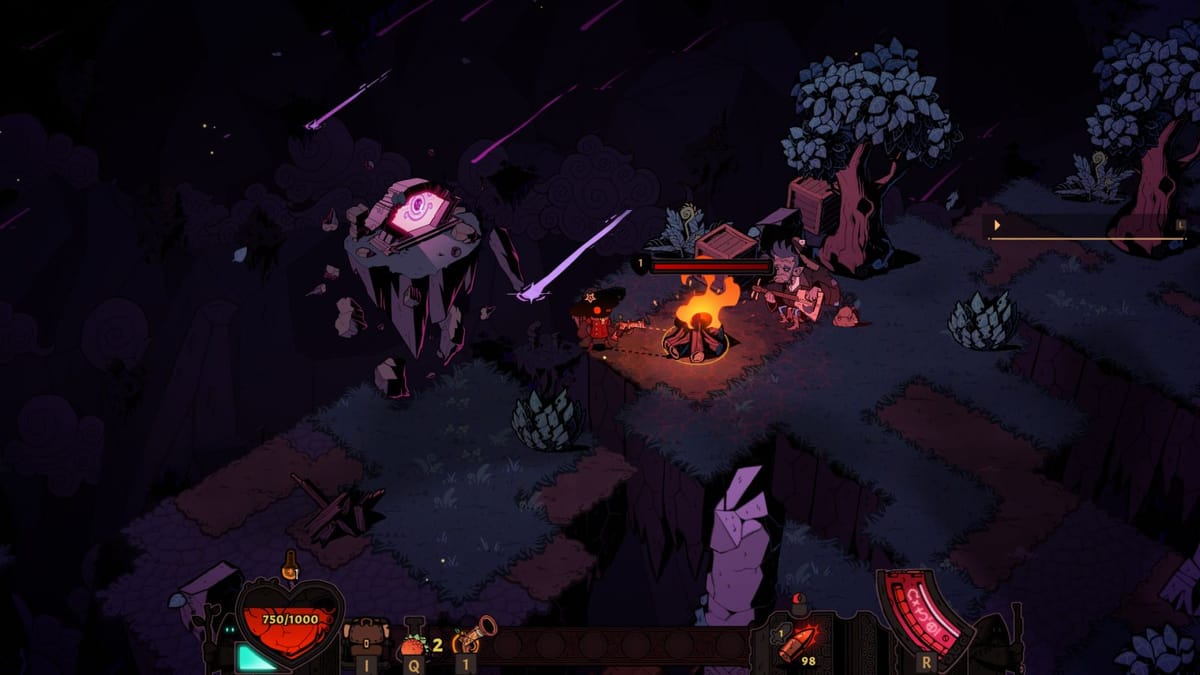
You might have seen Wizard with a Gun while browsing on Steam, or maybe you saw it on the Las Vegas meme orb (RIP Devolver Digital’s bank account). I’ve had my eye trained on this game through a rune-engraved scope for a while now. There was something about the rugged yet cozy 2.5D Isometric art style that caught my eye, but it was the promise of a deep arcane arsenal with interesting synergies that had me locked in. I can happily report that the devs over at Galvanic Games have enchanted Wizard with a Gun with the creatively destructive magic touch that the survival sandbox genre has been waiting for.
The plot has you thrown into the thick of it immediately. Your sky ship crashes, and now you’re stuck in the Shatter, a realm that’s in a continual loop of destruction and resurrection. The beings of chaos destroy the shatter time and time again, only to have the apocalypse rewound by Hilda, the creator of gunmancy, and her posse of riders. They use a time machine called “the Chronomacner’s Wheel” that resides in a mysterious tower built by ancient gods, in a futile attempt to stop the end. However, chaos has since destroyed the wheel, and the riders are stuck in different parts of the tower.
There is good news, you’re now in control of the tower, and it will serve as your base of operations. From there, you have direct access to the chronomancer’s wheel. The bad news is the riders have the gears that make the machine function, and they don’t trust you. You need to get the gears back from them, by force. However, the riders aren’t the only ones with gears, there are others with them throughout the map. This is the core gameplay loop: rewind the clock, explore the Shatter to hunt down the enemies with gears, gain enough gears to unlock a rider boss, plug the boss’s gear into the wheel, unlock a new biome, and finally, push the chaos back. Now throw into the mix that you have five minutes until the apocalypse starts after leaving the tower, and we’ve got a fun dynamic that’s less cat and mouse, and more like a cat, a mouse, and another cat in a burning building.
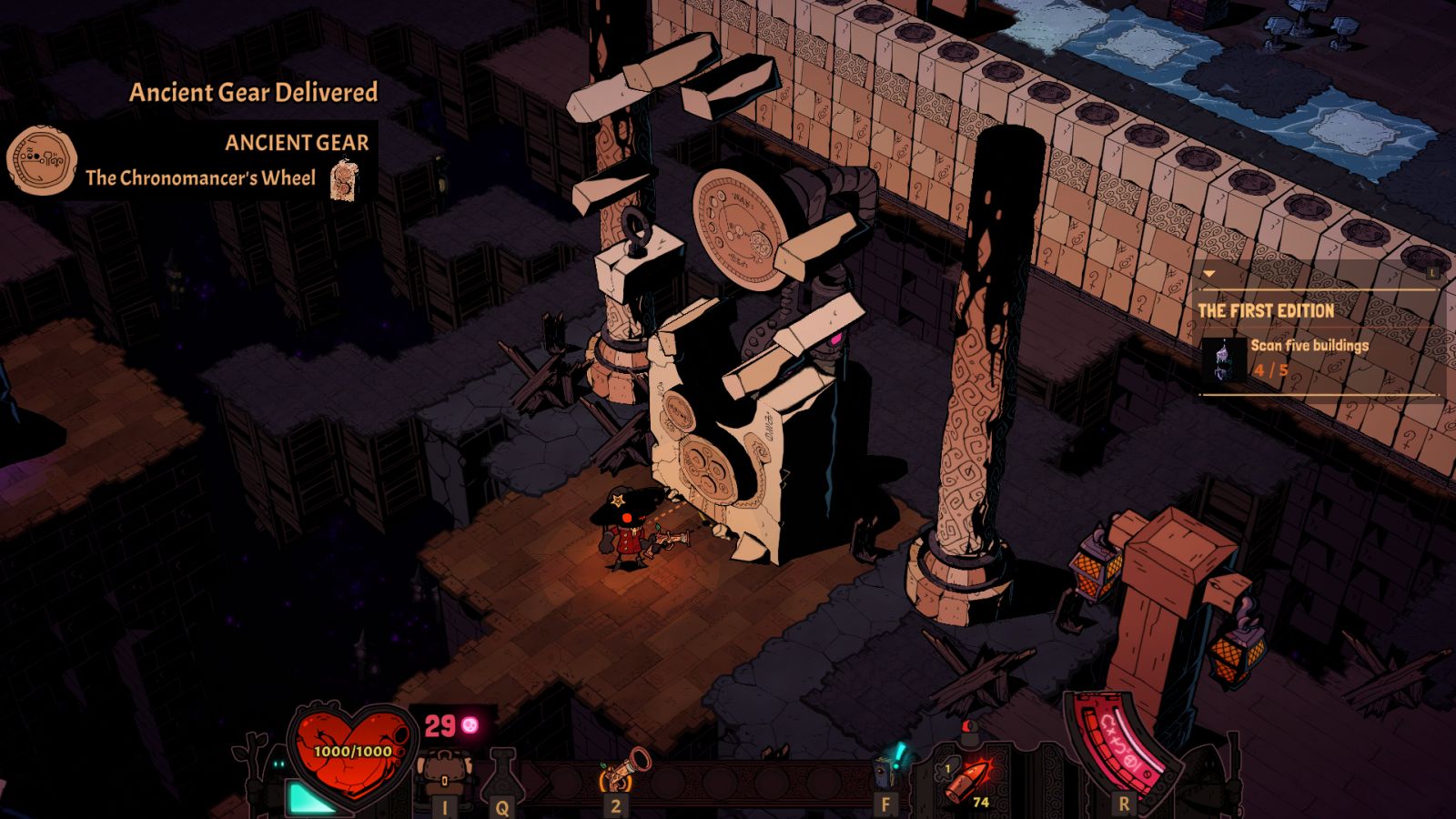
However, before you can do any of that, you need to finish the tutorial of course. You’re contacted by a mysterious construct of blue light called the cryptomancer who needs your help. It makes a point to state that you’re the contingency plan for this whole operation, not the primary plan of attack, but you’ll do.
From there the tutorial starts, and you have to find a gun. Before that, you learn to get about without one. This is where the dodge mechanic is introduced, a typical combat roll with generous I-frames. The first enemy you face is a stationary turret with mortar and missile attacks. I pridefully tried to beat it up with my bare hands, only to be humbled quite quickly. However, I soon came across some healing fruit, an oak apple, beneath a tree. I finally crafted a gun, made of wood. I appreciate the subversive take on the wizard’s wand. Guns are used for everything from combat to placing flooring and building whatever you need.
During my first encounter with the beings of chaos, I ran out of ammo. I guess I shouldn’t have shot at just about every tree in the area, but when the whole world is destructible, you really want to destroy it. I had to scramble to make a new gun in the heat of combat, it was intense. Mind you, this was all just in the tutorial. From there I entered the tower.
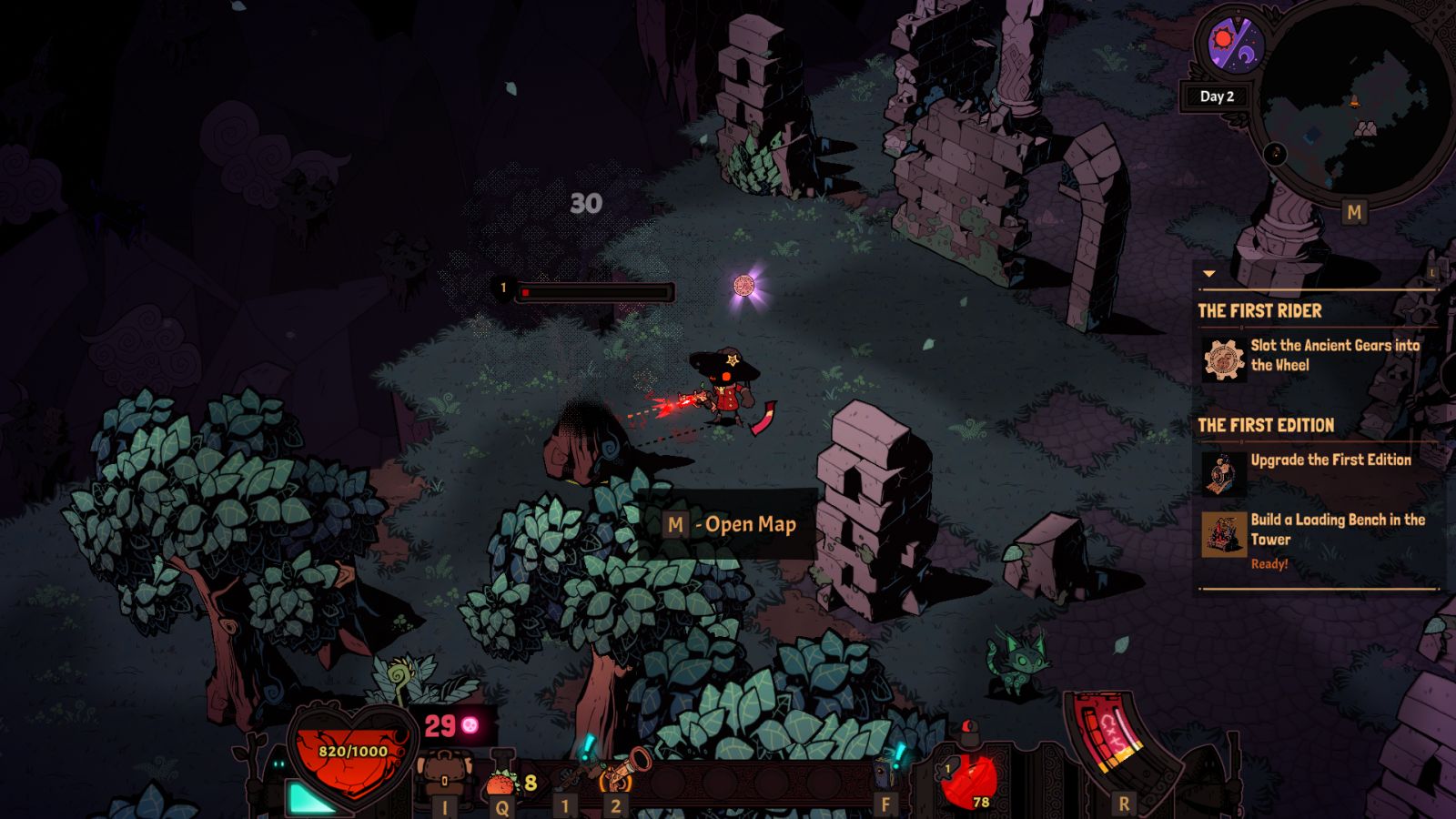
Exploring the wonder-ridden world that the devs have carefully engineered with procedural generation is invigorating until you realize that you’ve overstayed your welcome, the clock is at one minute ‘til midnight, and you’re deep into the map. Soon, chaos will spew into the world. You might think your most pertinent objective would become: get the hell out of dodge. However, you might want to use the chaos of the apocalypse to your advantage. The beings of chaos are less creatures and more forces of nature. They destroy EVERYTHING in sight with their corrosive energy, even the ground will deteriorate. At one point, when I exited their attack range, they switched targets and started attacking a tree. They aren’t picky, just hostile.
There are ways to delay the end. Every once in a while a chaos portal will spawn close by. Destroy it and activate its remains, and you’ll gain a good thirty seconds added to the timer. There are also stationary portals throughout the map, but don’t be fooled, they’re not so easy to put down, and they will call for backup. The harder the portal, the more time added to the countdown ‘til doomsday. Remember, you need to interact with the portal’s remains after it’s destroyed, so be careful how you fight the chaos that emerges, as it is corrosive. There’s a good chance that you cut yourself off from the remains of the portal, or something menacing stands between you and those oh-so-precious additional minutes. I’m usually not a big fan of timed conditions in games, but the countdown to chaos feels fair yet menacing and adds so much to the emergent gameplay that I really can’t help but love it.
On the other hand, doomsday doesn’t immediately destroy the world, it takes time for chaos to corrode everything. Like I said before, you might want to use the apocalypse to your advantage. Most creatures and entities belong to some kind of group, whether that be animals, machines, humanoids, and of course, chaos. You can usually bait enemies into fighting other enemies if you wrangle them right. I used this trick no shortage of times, even on the mini-bosses with gears. Infighting adds greater meaning to the apocalypse and creatures of chaos and makes the world feel dynamic.
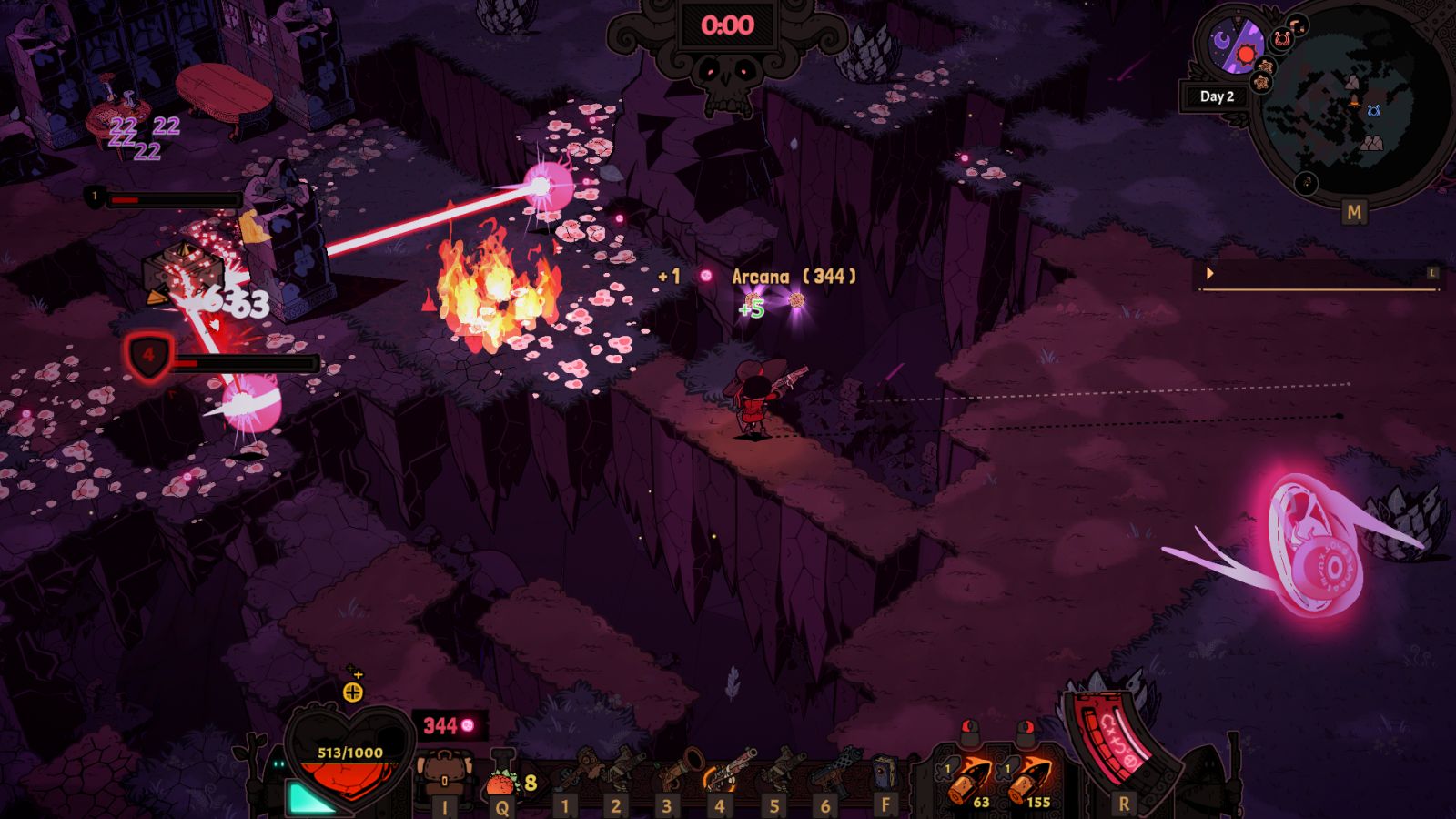
I remember when I was trekking through the frozen northlands with under-leveled equipment, and was setting up to take on a giant barbarian with a gear. I saw at the top of my minimap that a chaos portal was around. I ran to the portal, activated it, and had the abomination that came out chase me, and then hit the barbarian. The two titans clashed, pushing each other around the tundra. Pieces of the world peeled away as the chaos monster tried to atomize the barbarian, but the rugged northerner cleaved away at the vile entity with his axe. In the end, the barbarian won, and with low health at that. I fired off a single shot to finish him off, grabbed the gear, and took a second to embrace the carnage.
There are a lot of moving parts to Wizard with a Gun, and I rarely saw them snag on each other, but it did happen on occasion. My first taste of death came when I was far away from the return portal, and one of the creatures wielding the gear I needed died on a small patch of land. That land then became an inaccessible island after the creatures of chaos melted the ground away. It was before I had unlocked “The Groundlayer”, a gun that lets you place floor tiles, so I couldn’t have gotten to it regardless. It sucked, but it also taught me the value of preparation, and to take caution when dealing with chaos. From then on out, I was always cautious of my escape routes, and if I were to use the Groundlayer for making a bridge, then I would reinforce it and carry extra materials to back it up in case chaos decides to melt it. It’s also important to know when you should cash out. You don’t need to collect all of the gears in one go, you can return to the tower at any time through the portals.
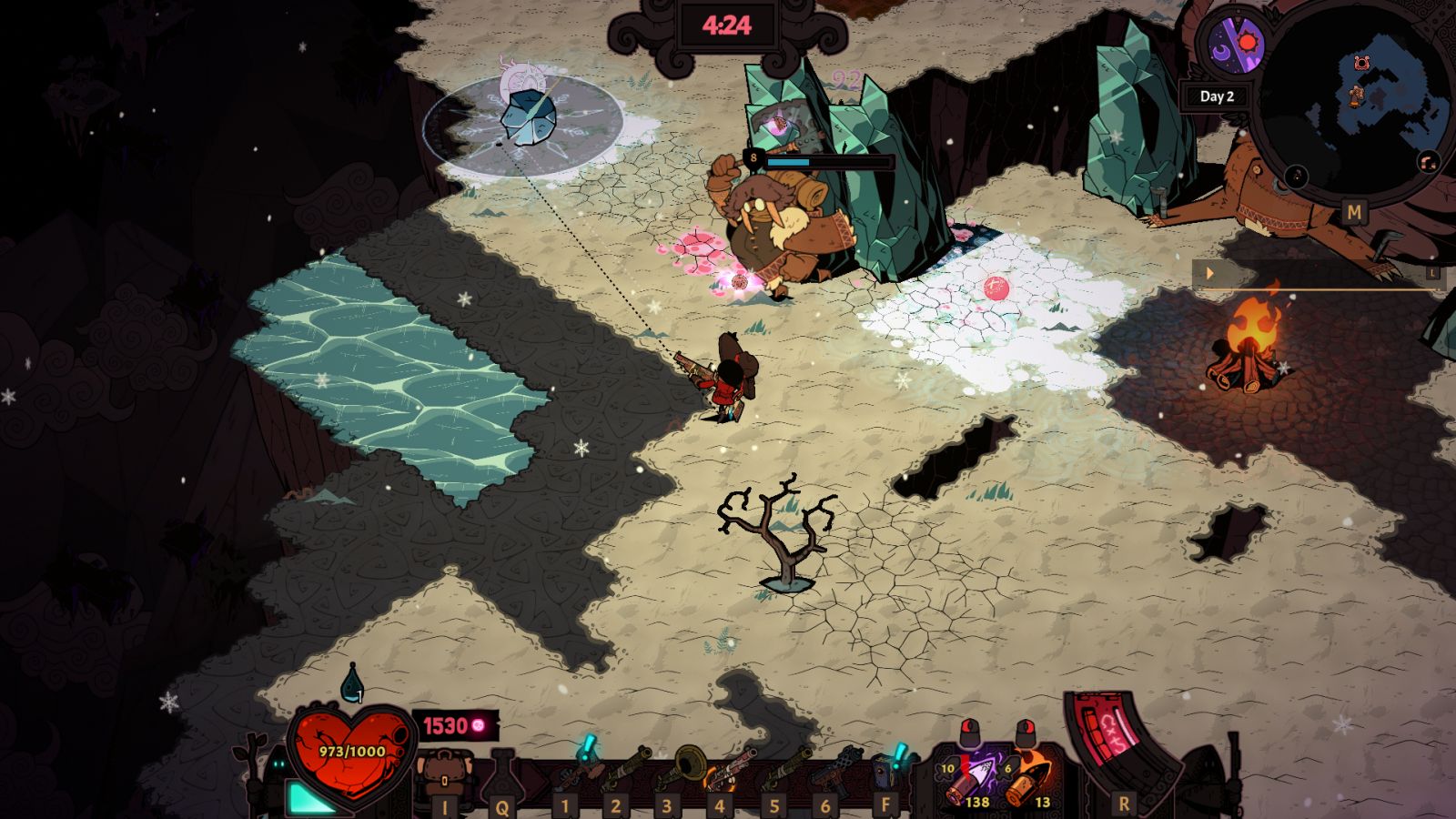
Enemies aren’t the only ones who get to affect the world around them. When the devs say this game is a sandbox, they mean it, and it leads to some of the best emergent gameplay I’ve experienced in years. Combine the guns, weapon effects, destructible environments, and faction behaviors, and you’re in for a wild ride. As a gunmancer, you have four firearm archetypes at your disposal: pistols, SMGs, blunderbusses, and carbines. The guns themselves are what you’d expect, it’s the ammunition that adds the spice to our war crime souffle. Ammo has two components to it, spells and powders. Spells are elemental types, such as fire, ice, lightning, poison, and more out there concepts like order and charm. You can infuse the different spell types you have with powders, which add effects like critical damage, bigger AOE, faster and slower projectile speed, ammo that regenerates the ground, and many other synergistic and unique effects. On top of that, guns have different chambers, so you can have two unique types of ammo for each gun and six guns in your hot bar. The combinations are limited only by your creativity. Maybe you have one bullet that tames a creature and another that can heal it, bam now you’re a summoner/support class. Maybe you just want to watch the world burn and have a gun with high AOE oil bullets in one chamber, and rapidly spreading fire in another, bam now you’re a pyromancer. There’s so much to tinker with, and you’re never limited in how you combine spells and powders.
Spells don’t just add basic element types to your gun, they also interact with the world around them in relation to both crafting and combat. Let’s say you shoot an old metal fence with a flame bullet, you’ll get standard iron scrap. However, if you shoot it and break it with electric rounds, you’ll get an electric iron ingot. A pivotal component for some upgrades. Are you being chased by a horde of bandits? Lure them into a river and shoot it with electric bullets! Fire will spread, Ice will freeze water, and lightning will arc to multiple enemies. Now throw completely destructible environments into the mix, and you have the recipe for expertly rewarding a player’s ingenuity. Although keep in mind, a carbine with chain lightning rounds sounds nice until one of the bolts arcs to a baby goat, and it cries to its whole entourage to headbutt you senseless. Those goats will track you to the ends of the Shatter if you’re not fast enough, you have been warned.
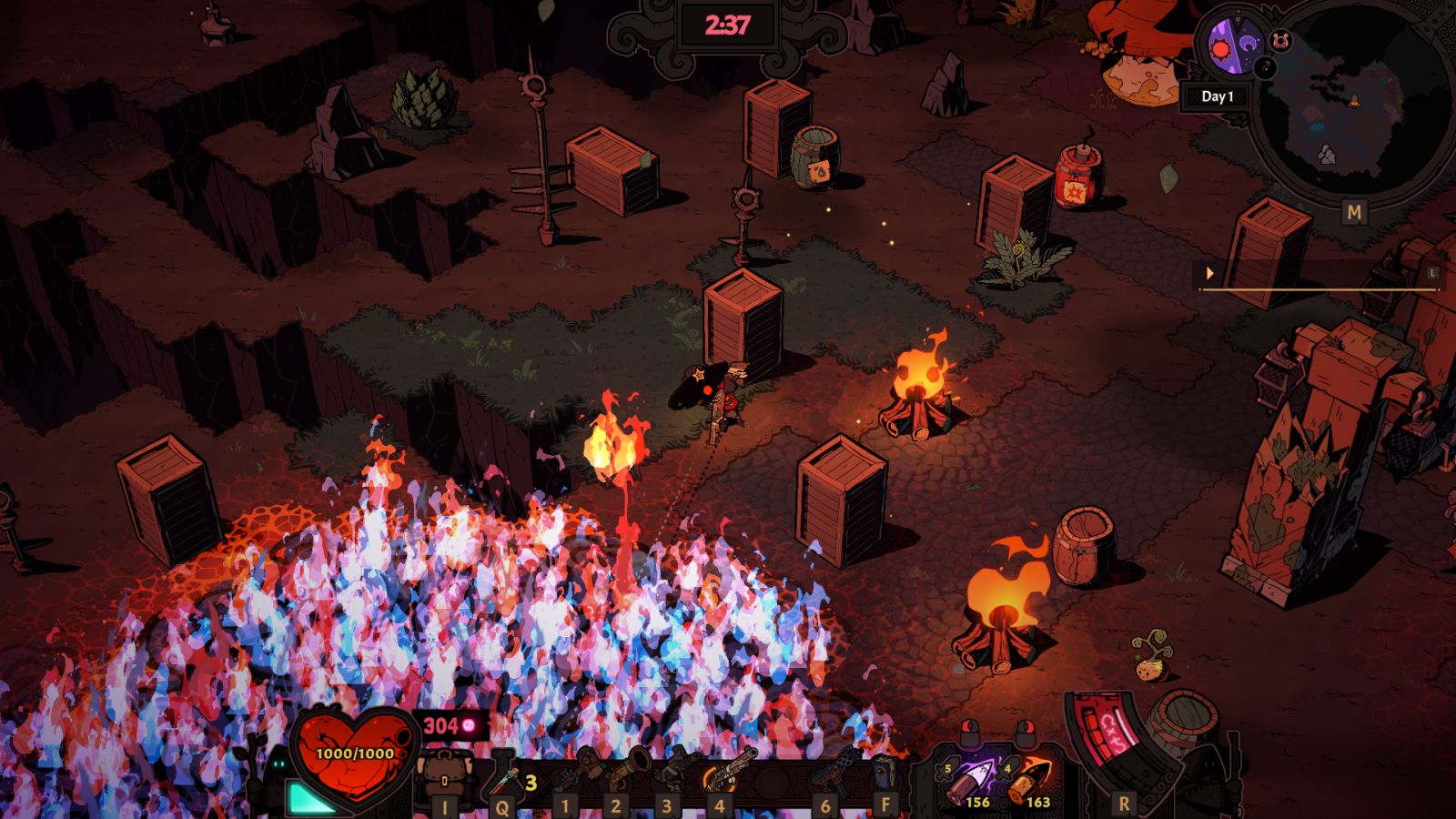
This all begs the question, how do I get more powerful guns, more spells, and better gear? Well, you’re equipped with a spellbook called “The First Edition.” It can scan enemies, allies, and decor to give you both new recipes and lore entries. You can then seek out Young Joshua, a gunsmith who will craft guns for you if you have the materials. However, bandits have stolen his blueprints, so you’ll have to face ever more dangerous gangs to get the blueprints for better weapons. The higher the quality of the guns, the higher the damage and the more powder effects you can have, meaning more room for interesting synergies. That being said, between elemental effects, attacks from enemies, and the environment deteriorating, sometimes the screen can get too visually noisy, and it can be hard to tell what’s happening and what to anticipate with all of the effects.
There are some minor frustrations, such as how the first edition can’t scan the books lying about the chambers of the tower or the boss rooms. I like the lore and would like a consolidated place to read all of it and put the pieces of the story together. There’s also the hassle of scanning enemies while trying to fight them, as every time you’re hit, the scan resets. Nothing is more frustrating than trying to scan an enemy who has no chill, but the sense of accomplishment and lore entry are both well worth it.
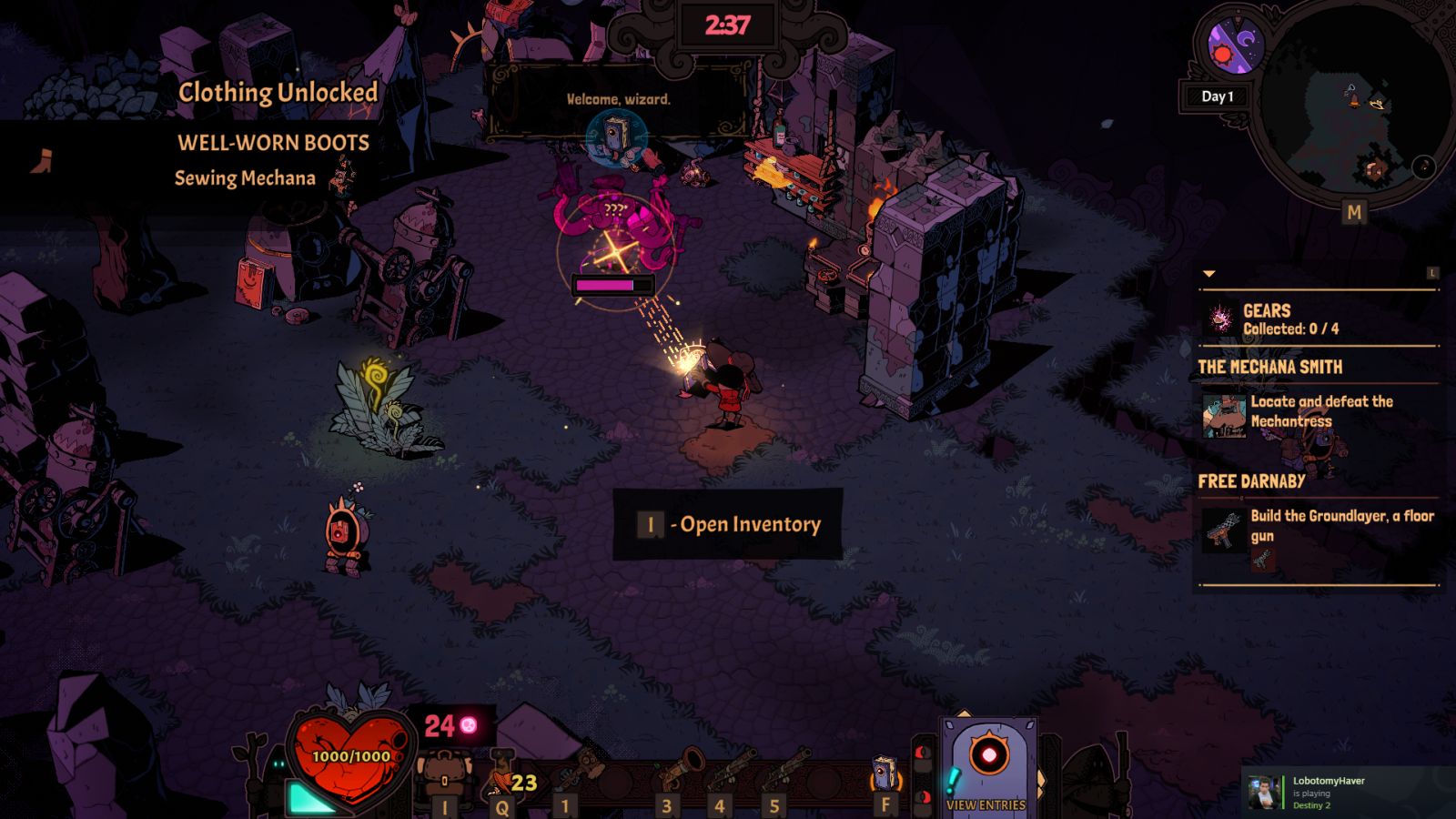
This game will throw curveballs at you, it’s part of the fun, but it can also subtract from the experience. What happens when one of the enemies with the gears is actually a friendly Cthulhu-esque entity who just wants to take care of his space commune and farm his swamp lettuce? He even tips his hat to you as you walk by! Well, you have to kill him for his gear, which comes across as odd in a game that emphasizes creative thinking. It’s a survival crafting game, so there are plenty of items I could give him to trade for the gear, but alas, it was his fate. I will give it to the devs, such brutality does add to the rugged Western theme.
All in all, I’m overjoyed with the overworld experience, from battling the forces of chaos to strategizing how I’ll take down a special enemy, to gathering supplies, everything feels purposeful. Every time I took down a boss and earned a new biome, my sense of astonishment with the game was taken to another level, and the feeling of wonder refreshed.
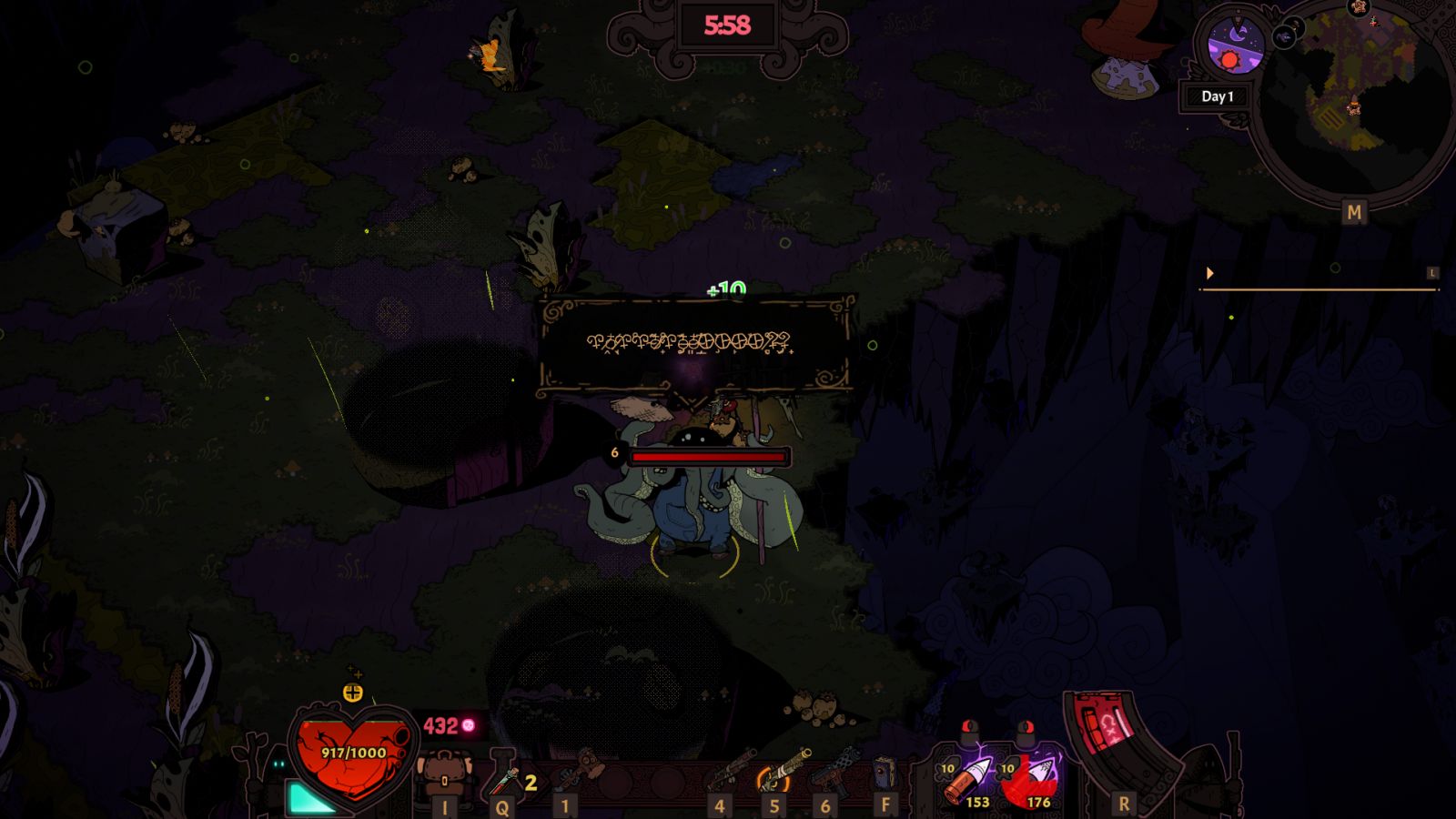
Now it’s time to talk about the tower. It’s your home, your research facility, and the place where the old gods decided to leave the chronomancer’s wheel. When you first get inside, the ground is ripped up, and you can see the void, revealing the tower’s status as floating through the ether. As you explore the overworld, you’ll find more portals that lead back to different parts of the tower. My tower took on the appearance of a spider’s web, with a main area where I set up all of my research stations, and the paths of wood winding out towards the portal rooms. Use the portals as leverage to spawn in a corresponding biome and get closer to objectives.
There’s also the research aspect to consider when planning out your tower. Every new elemental type requires its own research table. They take up space and require resources to develop new and higher-level effects in their branching skill trees. It helps that the polish and quality of life are on point. Everything you need to build, crafting stations, research tables, and even decor can be built with “the Worldbuilder”, a crafting gun. Of course, you need materials first. While gathering materials you can hold E to pick up everything in the area. When it comes to researching new spells, if you place a chest next to a research station then it will share its inventory, saving plenty of time running between chests and stations. If you insist on doing it the old-fashioned way, then there’s quick stack and take all options for chests. Of course, you might just want to make your tower look cool, and you can do just that with the plethora of options for decorations. It’s been a while since I’ve played a game that respects your time as much as WWAG does.
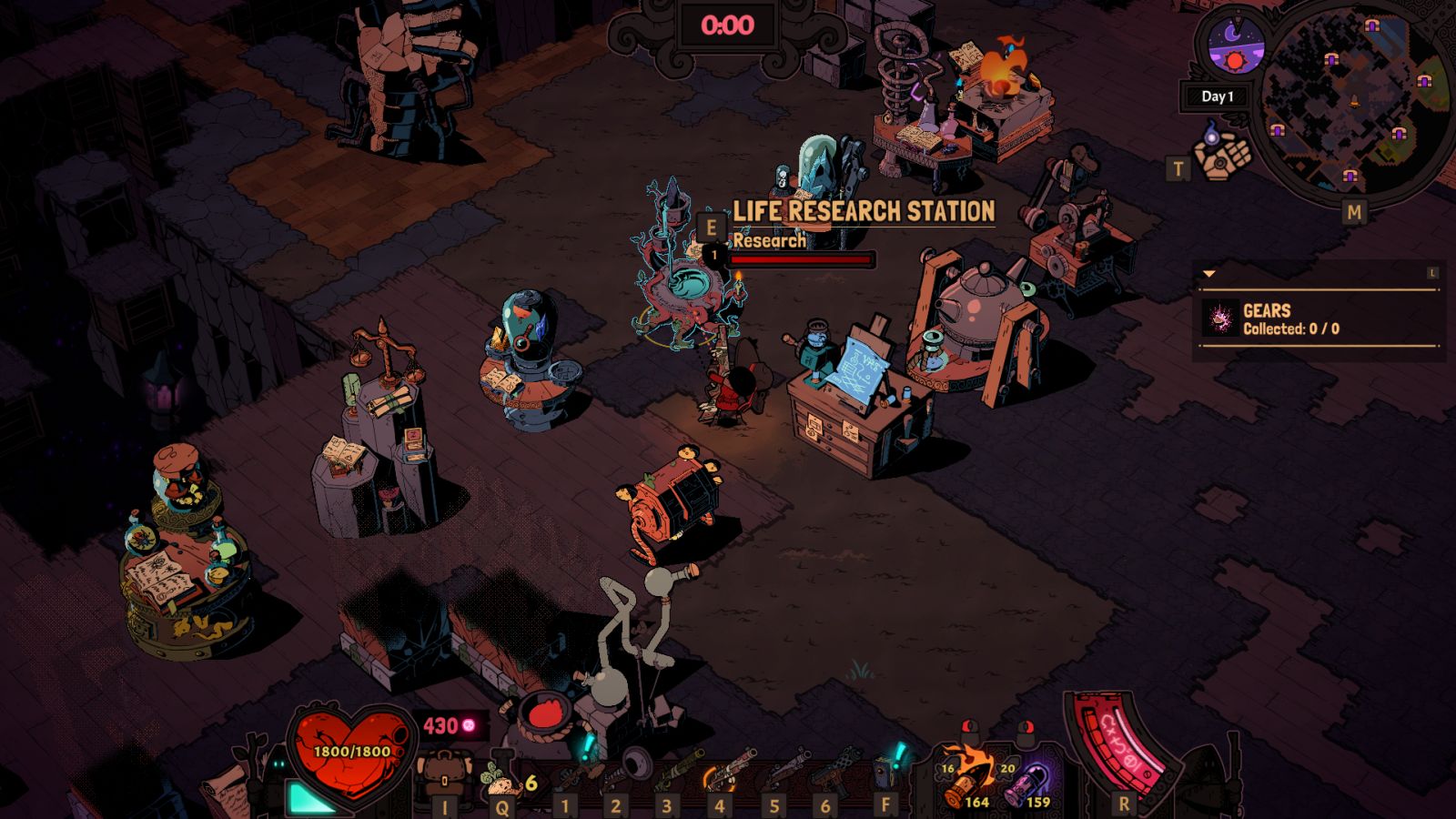
To wrap up, I need to talk about the aesthetics. The graphics are delightfully cartoony, yet surprisingly deep. Just how much personality can be imparted onto your wizard through basic character customization is an ode to the art design. Something as little as the eye shape can change your wizard’s personality drastically. Not to mention the abundance of outfit options and upgrades available at the sewing machine. Hats, gloves, robes, boots, and many more options can be altered to look the way you want and add buffs like health regen and faster movement speed. The silhouettes are also immaculate. Looking through the first edition at the outlines of enemies which I hadn’t researched yet was exciting.
Even the UI elements are on point. The health bar is an anatomically correct heart shoved into the frame of a symbolic heart, and the magazine is pictured at the bottom right, slowly decreasing as you fire off shots. There’s also the little details that come together to form the big picture. One of the characters has a rifle, and if you look closely you’ll notice that the scope is an eye that blinks. The chronomancer’s wheel breaks apart and reforms whenever you turn back time in a majestic animation. The music is also tied into the smaller details, as every button on the main menu has a guitar chord tied to it. I can’t wait to see people dump hours into mastering this. That’s to say nothing of the actual soundtrack. Composer Ryan Ike hit the ball out of the park with the score. Guitar and synth blend together with chanting in a way that elevates the Western theme while standing out as unique. On every level, the aesthetics of WWAG elevate the rest of the game by adding tension or a feeling of wonder.
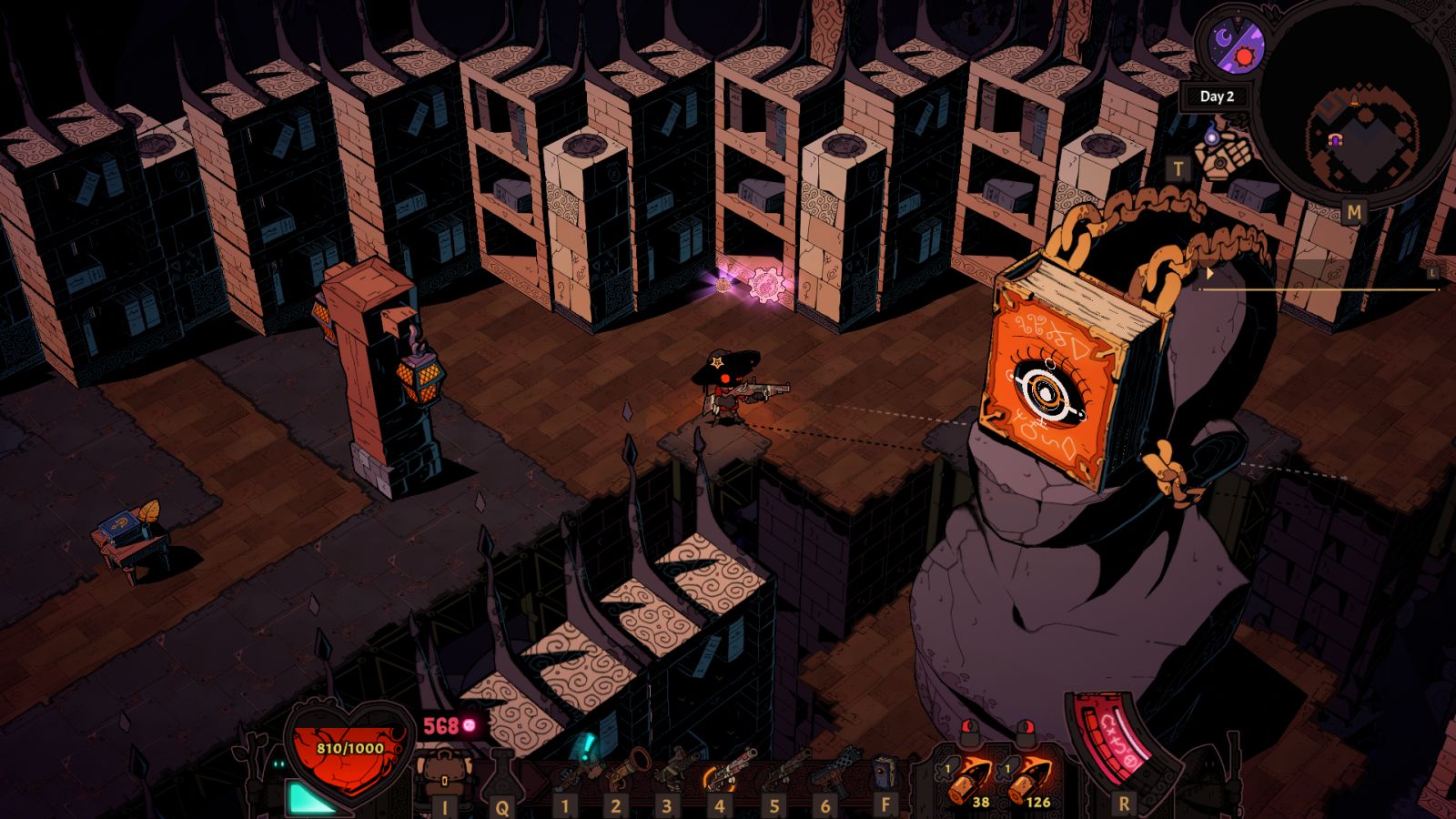
Overall, all of the pieces of Wizard with a Gun fit together like the gears of the chronomancer’s wheel, magically. The devs did an immaculate job tying every aspect of the game together in a way that drives emergent gameplay. If you’ve been searching for a game where your options for destruction, regeneration, and everything in between are truly deep, then Wizard with a Gun is for you.
Wizard with a Gun
Excellent
Wizard with a Gun excels at providing players with a deep magic system and a wild world to inflict it on. With the world hanging on by a thread, it’s up to you to rewind time again and again until your mission is complete.
Pros
- Fantastic combat that encourages creative thinking
- Divine soundtrack elevates fights and exploration
- Mystifying lore and setting
Cons
- Can get a little too visually noisy at times
- No peaceful options for dealing with passive NPCs
